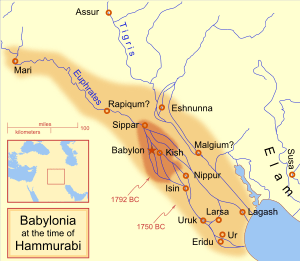Akkad (city) facts for kids

Akkad (also spelled Accad or Agade) was a very important ancient city. It was the capital of the powerful Akkadian Empire. This empire was a major force in Mesopotamia (which is mostly modern-day Iraq) for about 150 years. This was a very long time ago, around 2300 to 2150 BC.
Even though Akkad was so important, its exact location is still a mystery today! Historians and archaeologists have been searching for it for a long time. They think it was somewhere in central Iraq, not far from modern Baghdad.
The main goddess of Akkad was Ishtar-Annunitum. She was seen as a powerful, warlike goddess. Her husband, Ilaba, was also worshipped. These gods were later honored in other cities like Girsu and possibly Sippar.
The city of Akkad might even be mentioned in the Hebrew Bible. It appears in the book of Genesis as one of the cities built by a famous ancient ruler named Nimrod.
Some experts believe that the name "Agade" (another name for Akkad) might not have come from the Akkadian language. This could mean that the city existed even before the Akkadian Empire began.
Where Was Akkad?
Finding the exact spot of Akkad is a big puzzle for archaeologists. Many different places have been suggested over the years. Most ideas point to an area in central Iraq, close to modern Baghdad. This area is near important ancient cities like Eshnunna, Sippar, Kish, and Babylon. It's also thought to be close to the Tigris River and the Diyala River.
One possible location is a large ancient site called Ishan Mizyad (also known as Tell Mizyad). This site is about 5 kilometers northwest of Kish. When archaeologists dug there, they found remains from the Akkadian period and later times. They even found many old texts that were lists of workers from the Akkadian period.
Ancient travel records from a city called Mari suggest that Akkad was located between Sippar and another city called Khafajah. This would place Akkad on the Tigris River, just south of modern Baghdad, near where the Tigris and Diyala rivers meet. These records also hint that Akkad was at a place where people could cross a river.
Other old records suggest Akkad was in the area of Eshnunna, in the Diyala Valley. This means it was northwest of the main Sumerian region. It seems that the rulers of Eshnunna continued to honor the gods of Akkad even after the Akkadian Empire ended.
Another suggested spot is Tell Muhammad, which is in the southeastern suburbs of Baghdad. However, no remains from the Akkadian Empire period have been found there yet.
A different idea points to a place called El Sanam, near Qādisiyyah. A piece of a very old Akkadian statue was found there. This statue was originally very tall, about three meters high! Part of this site has been worn away by the Tigris River.
The search for Akkad continues, and each new discovery helps experts get closer to solving this ancient mystery.
See also
 In Spanish: Agadé para niños
In Spanish: Agadé para niños
- Cities of the Ancient Near East
- List of Mesopotamian dynasties
- History of Mesopotamia
- List of kings of Akkad


